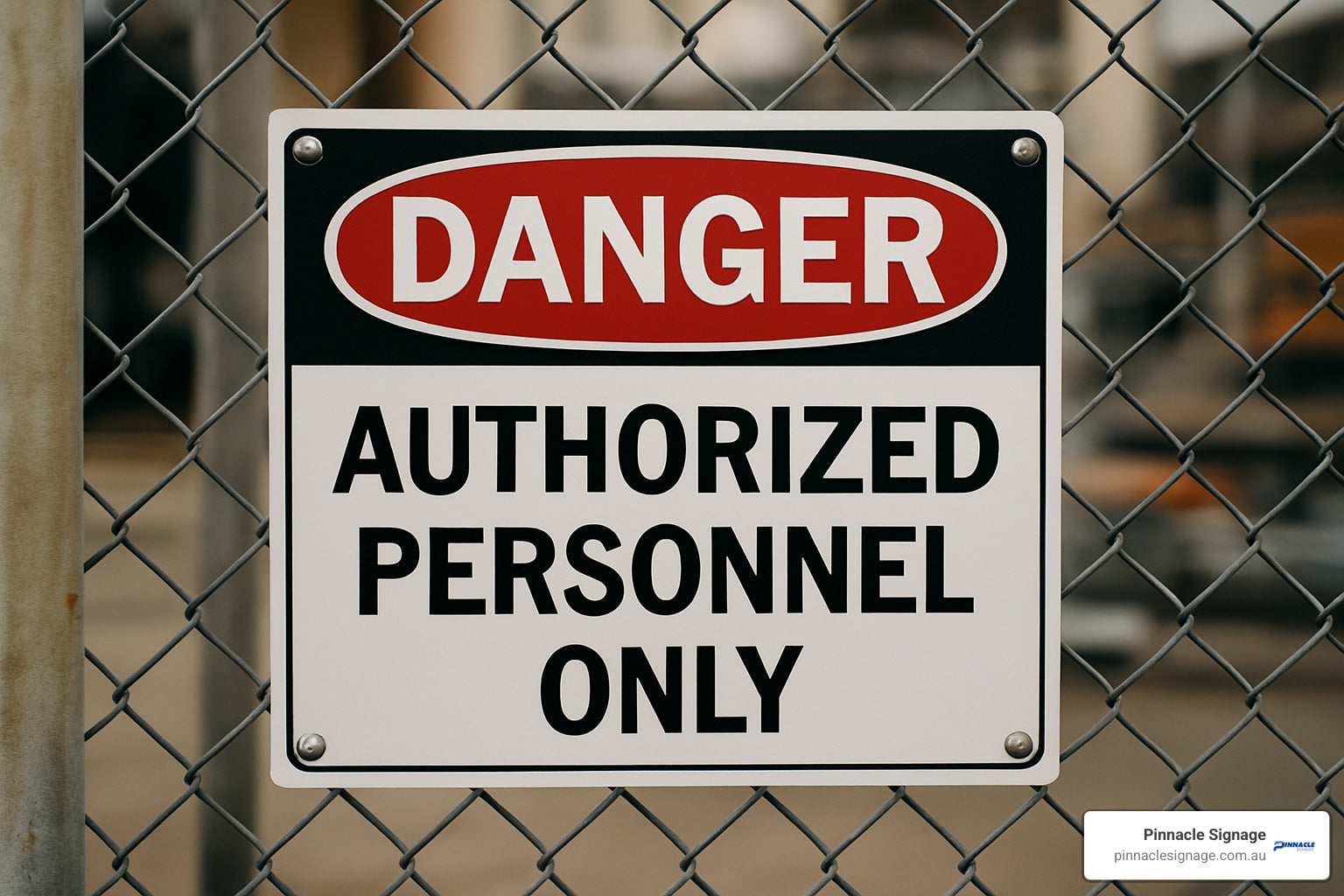
The Ultimate Guide to Custom Danger Signs
Why Custom Danger Signs Are Critical for Workplace Safety
Custom danger signs are specially designed safety signs that communicate specific life-threatening hazards in your workplace. Unlike standard signs, they can be custom with precise messaging, specific hazards, and unique identifiers to address your exact safety needs.
Quick Guide to Custom Danger Signs:
- Purpose: Warn of immediate, life-threatening hazards
- Compliance: Must follow OSHA/Australian standards with red, black, and white color scheme
- When to Use: For severe hazards with high probability of death or serious injury
- Customization Options: Specific wording, hazard symbols, sizes (3.5"×5" up to 36"×36"), materials (aluminum, vinyl, plastic)
- Turnaround: As quick as 2 business days for urgent workplace needs
Custom danger signs serve as your first line of defense against workplace accidents, protecting both workers and visitors from potentially fatal hazards. They differ from standard danger signs by allowing you to address specific risks unique to your worksite—whether it's rare chemicals, specialized machinery, or unusual environmental dangers.
These signs aren't just helpful—they're often legally required. Australian OHS regulations are quite specific about signage requirements, and generic signs may not adequately communicate the exact nature of your site's hazards. When lives are at stake, the ability to clearly specify "Danger: High Voltage Junction Box - Authorized Personnel Only" rather than just "Danger: Electrical Hazard" can make all the difference in preventing accidents.
The red-black-white color scheme isn't just tradition—it's designed for maximum visibility and instant recognition of severe danger. This standardized format ensures workers immediately understand the level of risk, even before reading the specific warning message.
I'm Doug Lindqvist, General Manager of Pinnacle Signage, and with my experience in the safety and industrial supply sector, I've seen how custom danger signs can prevent workplace accidents and ensure regulatory compliance across construction, mining, and manufacturing sites throughout Australia.
Why Custom Danger Signs Matter for Australian Worksites
From the scorching outback mining sites to coastal construction zones battling salt spray, Australian workplaces face unique challenges that off-the-shelf signage simply can't address properly. When it comes to protecting your workers from life-threatening hazards, generic just doesn't cut it.
Custom danger signs aren't just a nice-to-have—they're often essential for proper hazard communication in our distinctive Aussie work environments. They make a real difference because they directly address the specific risks your team faces every day.
When you invest in custom danger signage, you're not just ticking a compliance box. You're creating clear, unmistakable warnings that can prevent serious accidents. These signs become your first line of defense, communicating critical information that could literally save lives on your worksite.
The data speaks for itself—danger signs are reserved only for situations with high probability of death or serious injury. They represent the most severe category of safety signage, which is precisely why customisation matters so much when standard options fall short.
At Pinnacle Signage, we've seen how worksites with properly customised danger signs experience better hazard awareness and fewer safety incidents. It makes perfect sense—when your team can immediately recognise and understand the specific danger they face, they're naturally more likely to take the right precautions.
What sets custom danger signs apart from standard options?
Standard danger signs work well enough for common hazards, but many Australian worksites deal with unique situations that demand more specific solutions. Here's what makes custom danger signs so valuable:
When you choose customised signage, you get specific wording that precisely describes your particular hazard—not generic warnings that might be misinterpreted. You can include unique symbols that wouldn't appear on standard signs but perfectly represent your specific risk.
For sites with specialised equipment, you can add site-specific details like location identifiers or equipment numbers that make the warnings more relevant and actionable. If you're dealing with unusual materials, you can create specialised warnings for rare chemicals or uncommon hazards that standard signs simply don't cover.
Many Australian worksites employ diverse teams, so multilingual options ensure everyone understands the danger, regardless of their first language. This inclusivity isn't just good practice—it's essential for comprehensive safety.
Think about it: a standard "Danger: Electrical Hazard" sign might be woefully inadequate for a specialised electrical substation. But a custom sign reading "Danger: 33kV Transformer Station - Authorised Personnel Only - Call 0412 345 678 Before Entry" gives workers exactly the information they need to stay safe.
Custom signage becomes particularly valuable when your site features unusual machinery, site-specific emergency procedures, rare chemical compounds, multiple hazards in a single location, or temporary work conditions that change regularly. In these situations, standard signs simply can't communicate the specific nature of the threat effectively enough.
When lives are potentially at stake, the small investment in customised danger signage delivers immeasurable returns in worker safety and risk mitigation. It's not just about compliance—it's about genuinely protecting your team from harm in the unique Australian workplace you manage.
Key Elements of a Compliant Custom Danger Sign
Creating an effective and compliant custom danger sign isn't just about slapping some red and black text on a board. There's a bit of an art to it, and getting it right can literally save lives on your worksite.
Every proper danger sign needs several key elements to be effective and meet Australian requirements. The red header panel with "DANGER" in white text instantly signals the severity of the hazard. This sits above a white background that makes the black text of your hazard description stand out clearly. A black border frames the entire sign, creating that distinctive look that workers recognize immediately.
Don't forget about including appropriate hazard symbols or pictograms – these visual cues communicate danger even when someone's too far away to read the text. Speaking of reading, clear, legible fonts are non-negotiable, and they need to be sized appropriately for viewing distance.
Size matters when it comes to safety. A good rule of thumb is that for every metre of viewing distance, your text should be at least 5mm tall. So if workers need to spot the danger from 10 metres away, your text should be at least 50mm in height. This isn't just a good idea – it's what makes your sign actually useful in a real workplace situation.
For more detailed information about Australian standards for safety signs, check out our guide to understanding Australian standards.
Choosing the right material & finish
The harsh Australian climate can be brutal on outdoor signage. Your custom danger signs need to be tough enough to withstand whatever your worksite throws at them – from scorching sun to driving rain.
Aluminium signs (1.6mm) are our premium option, perfect for permanent installations that need to weather the elements. They're resistant to just about everything: UV damage, rain, heat, and even tampering attempts. For mining operations or coastal sites, this is often the way to go.
Adhesive vinyl offers flexibility when you need to apply warnings directly to equipment, walls, or doors. It's cost-effective and works brilliantly for indoor applications or shorter-term outdoor use.
Need something for a temporary construction site? Corflute (in 3mm or 5mm thickness) gives you a lightweight but durable option that's easy to move and reposition as your site evolves.
For vinyl signs that need to face the harsh Australian sun, adding a UV laminate layer provides that extra protection against fading and deterioration.
The right material choice depends on your specific environment. Food processing areas benefit from easy-clean vinyl with antimicrobial properties, while chemical storage areas need chemical-resistant aluminium or specialised vinyl. Investing in quality materials now means your danger signs remain visible and effective when they're needed most – which could be years down the track.
Language, symbols & accessibility
A danger sign that isn't understood by everyone on your worksite isn't doing its job properly. When creating custom danger signs, consider the diverse needs of your entire workforce.
Use plain, direct English that clearly communicates the hazard without unnecessary jargon or technical terms. Keep messages concise but complete – "Danger: High Voltage" is good, but "Danger: High Voltage – Authorised Personnel Only" is better.
For worksites with diverse teams, bilingual options ensure everyone understands the risks regardless of their primary language. We've created many multilingual signs for clients across Australia, and they're particularly valuable in areas with high numbers of international workers.
Internationally recognized ISO symbols are your friends when it comes to universal understanding. They communicate danger instantly, even before someone reads the text. Make sure these symbols are large enough to be visible from the required distance and maintain proper contrast for maximum visibility.
Don't forget about accessibility considerations. Colour combinations should work for those with colour vision deficiencies (about 8% of Australian men have some form of colour blindness). In frequently accessed areas, consider tactile elements, and always position signs at appropriate heights for visibility by all workers.
For detailed information about chemical hazard symbols specifically, our guide on Know Your Hazard Symbols breaks down everything you need to know.
An effective danger sign isn't just about meeting minimum requirements – it's about ensuring everyone on your site can understand and respond appropriately to the hazards present. That's the true measure of success for any safety signage program.
When to Choose Custom Over Standard Danger Signs
While standard danger signs work well for common hazards, there are specific situations where custom danger signs become essential for proper safety communication and compliance. Knowing when to invest in customisation can make all the difference between adequate protection and truly effective hazard warnings.
In my years at Pinnacle Signage, I've seen countless worksites where standard signs simply didn't cut it. For instance, when dealing with specialised machinery that has unique pinch points or operational hazards, a generic "Danger: Moving Parts" sign might not adequately convey the specific risk. This is where customisation becomes crucial.
You'll want to consider custom danger signs when your worksite features unique machinery that standard signs don't address properly. Maybe you're working with rare chemicals that require specific handling instructions, or perhaps you're managing temporary works where hazards change frequently. These situations demand clearer, more targeted messaging.
Multilingual crews are another compelling reason for customisation. Australia's diverse workforce often includes team members from various language backgrounds, and safety information must be understood by everyone on site. A custom bilingual sign can ensure critical safety messages reach your entire team, regardless of their primary language.
Some companies also prefer to incorporate their branding into safety signage for consistency across their sites. While safety always comes first, a professionally designed custom sign can integrate your company colours or logo alongside the required danger elements, reinforcing your safety culture while maintaining compliance.
Emergency plans often require site-specific information that standard signs simply can't provide. When workers need to know exactly who to call, what steps to take, or where to assemble in case of an emergency, customisation becomes not just helpful but potentially life-saving.
For those working with hazardous chemicals, understanding UN numbers and proper chemical signage is essential. These internationally recognised identification numbers help emergency responders identify specific substances, and custom signs can incorporate the exact UN numbers relevant to your worksite.
If electrical hazards are present at your site, you might also want to check out our guide on Don't Get Zapped for more information about voltage warning signs.
Quick decision checklist
Not sure if you need a custom danger sign? This straightforward checklist will help you decide:
- Hazard severity – Is the risk severe enough to warrant a danger sign? Danger signs are reserved for life-threatening risks.
- Absence of stock sign – Does a standard sign adequately describe your specific hazard?
- Regulatory demand – Are there specific wording requirements from industry regulators?
- Visibility gaps – Do standard options provide enough visibility in your particular environment?
If your hazard is truly unique, if standard signs don't quite capture the specific risk, or if you need to include emergency procedures that aren't covered by off-the-shelf options, then custom danger signs are likely your best choice.
At Pinnacle Signage, we've helped countless Australian businesses create effective custom danger signs that address their specific safety challenges. Whether it's a mining operation in the outback or a manufacturing facility in suburban Melbourne, we understand that sometimes standard just isn't enough when lives are on the line.
Product Round-Up: Best Custom Danger Signs for Immediate Deployment
When safety can't wait, our ready-to-deploy custom danger signs deliver the perfect balance of speed and specificity. At Pinnacle Signage, we've developed a range of customisable danger sign templates that can be quickly adapted to your exact requirements while maintaining full compliance with Australian safety standards.
Manufactured right here in Wagga Wagga using premium materials, these signs are built tough to withstand everything the harsh Australian climate throws at them—from scorching outback heat to coastal salt spray.
Danger Isolate Before Entry
Our Danger Isolate Before Entry sign is a worksite essential wherever lock-out/tag-out procedures are critical. This sign could literally save lives in electrical maintenance areas, machinery spaces, and anywhere power isolation is mandatory before access.
The clear, bold messaging leaves no room for misinterpretation—exactly what you need when dealing with potentially lethal electrical hazards. Available in various sizes and materials, you can choose aluminium for permanent outdoor installation or vinyl for indoor applications. For manufacturing plants, electrical substations or industrial settings, this sign provides that crucial final reminder before someone begins maintenance work.
Danger Snakes Present In This Area

Only in Australia would a snake warning be among our most popular safety signs! Our Danger Snakes Present In This Area sign addresses a uniquely Australian hazard that international sign standards often overlook.
Perfect for bushland work sites, rural properties, and construction areas that border natural habitats, this sign features an instantly recognisable snake symbol paired with clear warning text. The weather-resistant materials ensure it remains visible season after season, even under the harsh Australian sun. During summer when snake activity peaks, this sign serves as a vital reminder for workers to stay vigilant and wear appropriate protective footwear.
Danger Silica Dust Hazard – Avoid Breathing Dust
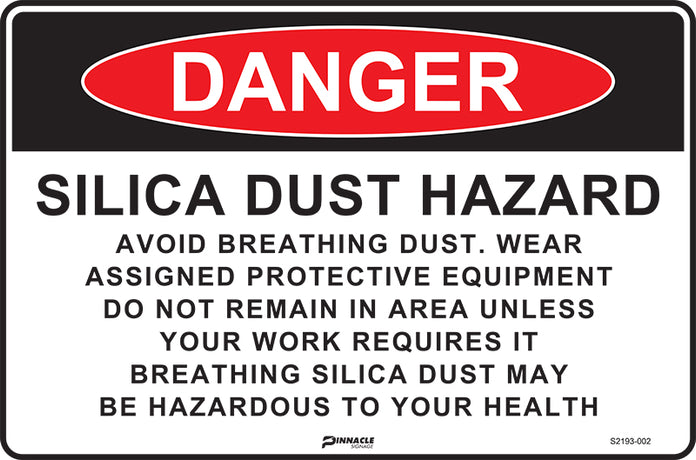
Silicosis has become a major concern in Australian construction and mining industries, making our Danger Silica Dust Hazard sign an increasingly essential worksite fixture. This sign clearly identifies the invisible but deadly threat of crystalline silica dust created when cutting, grinding or drilling concrete, stone, or ceramics.
The sign includes the internationally recognised respiratory protection symbol and specific instructions to avoid breathing dust. Made from materials that won't deteriorate in dusty environments, it serves as a constant reminder of proper PPE requirements and dust control measures. For construction sites, stone fabrication workshops, or mining operations, this sign addresses a serious occupational health concern that can lead to permanent disability or death.
Danger Keep Out – Authorised Personnel Only
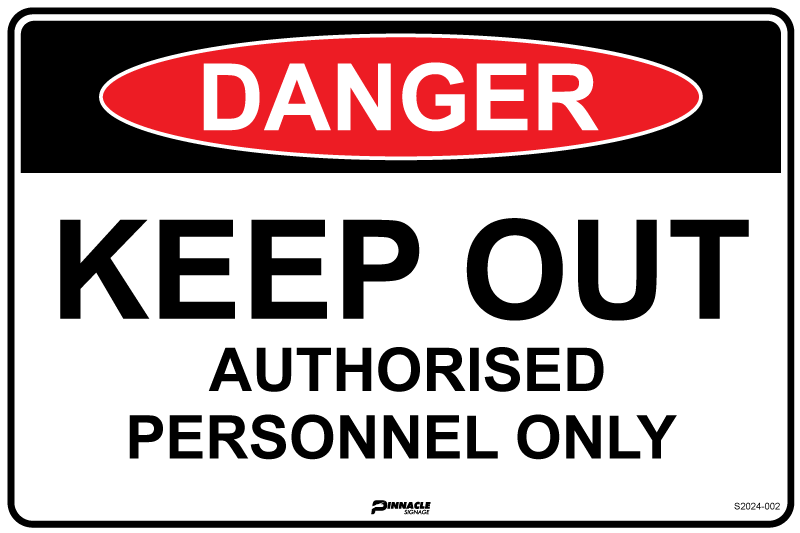
Some areas simply aren't safe for unauthorised access. Our Danger Keep Out – Authorised Personnel Only sign establishes clear boundaries with unmistakable authority.
This versatile sign works perfectly for electrical rooms, chemical storage areas, construction zones, and any location where untrained personnel could face serious injury. The bold, direct messaging is immediately understood by everyone, regardless of technical knowledge. Available in various sizes and durable materials suitable for both indoor and outdoor use, this sign can be further customised with specific hazard information or emergency contact details for your site's unique requirements.
Danger Do Not Enter
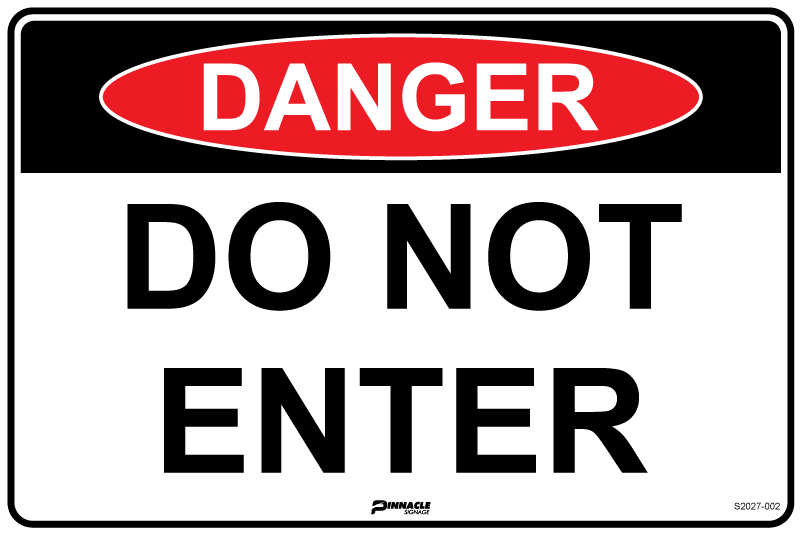
When you need the clearest possible "stay out" message, our Danger Do Not Enter sign delivers unambiguous communication that requires zero interpretation.
Ideal for demolition sites, unstable structures, areas with atmospheric hazards, or any space where entry presents immediate life-threatening risks, this sign creates an unmistakable warning. The high-visibility design is recognisable from a distance, making it effective even in poor lighting conditions. The durable construction holds up to temporary or permanent installation, ensuring your warning remains visible throughout hazardous operations.
Danger Deep Excavation
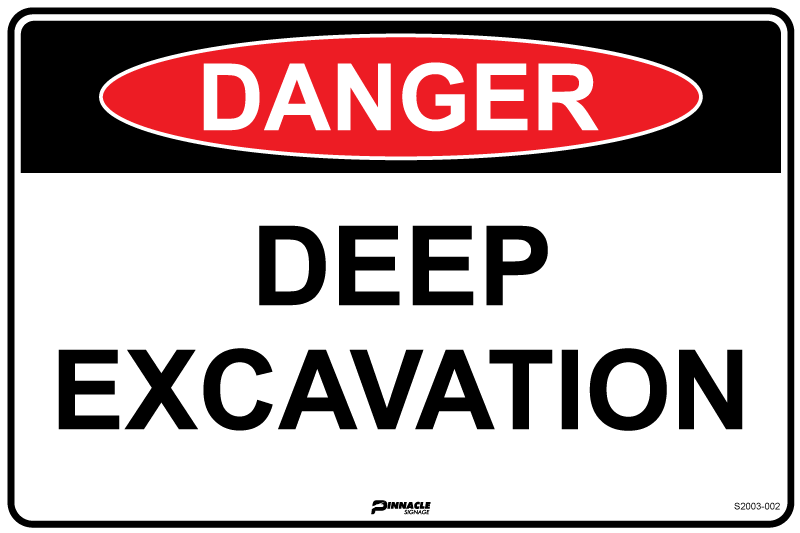
Falls into excavations remain one of construction's most preventable yet persistent hazards. Our Danger Deep Excavation sign provides clear warning of drop hazards at trenching sites, foundation works, and utility installations.
Manufactured specifically to withstand construction environments, these signs feature weather and UV-resistant materials that won't fade or deteriorate when exposed to the elements. Available in multiple sizes to ensure appropriate visibility based on your site layout, these signs alert both workers and passersby to dangerous drops that might otherwise be overlooked, especially in low light or visually cluttered environments.
All our custom danger signs can be ordered online with delivery typically within 2-3 business days across Australia. For urgent safety needs, we offer priority production options—because when it comes to preventing workplace accidents, timing matters.
Ordering, Installation & Maintenance Tips for Custom Danger Signs
Getting the most from your custom danger signs involves more than just good design—proper ordering, installation, and maintenance are equally important to ensure ongoing effectiveness and compliance.
Ordering Process
At Pinnacle Signage, we've streamlined the process of creating and ordering custom danger signs to ensure you get exactly what you need with minimal hassle:
- Select your base template from our extensive range of danger signs
- Customize your message to address your specific hazard
- Choose your size based on viewing distance requirements
- Select your material based on environmental conditions
- Review your design proof carefully before approval
- Confirm your order for rapid production and dispatch
Our team is available to provide guidance at any stage of this process, ensuring your custom signs meet both your specific requirements and all applicable safety standards.
Installation Best Practices
Proper installation ensures your custom danger signs remain visible and effective:
- Height placement: Install signs at eye level (approximately 1.5-1.7m from the ground) unless specific viewing conditions dictate otherwise
- Viewing angle: Position signs perpendicular to the typical approach path
- Lighting: Ensure adequate illumination or consider reflective options for low-light areas
- Obstructions: Keep the area around signs clear of vegetation, equipment, or other visual barriers
- Mounting: Use appropriate fixings for your substrate (wall, fence, post) and sign material
- Multiple viewpoints: Consider installing duplicate signs if the hazard area can be approached from different directions
Maintenance Routines
Even the most durable signs require regular maintenance to remain effective:
- Regular cleaning: Remove dust, dirt, and grime that can obscure messaging
- Damage inspection: Check for vandalism, weather damage, or fading
- Visibility assessment: Ensure signs remain unobstructed by new equipment or vegetation
- Relevance review: Confirm the hazard information remains accurate and up-to-date
- Replacement planning: Establish a schedule for sign replacement based on material lifespan and environmental conditions
We recommend conducting a formal sign audit at least annually, with more frequent checks in harsh environments or high-traffic areas.
Staying up-to-date with changing hazards
Worksite hazards aren't static—they evolve with changing processes, equipment, and regulations. To maintain effective hazard communication:
- Conduct regular site safety audits to identify new or changed hazards
- Review regulatory updates that might affect signage requirements
- Gather feedback from workers about sign effectiveness and visibility
- Document sign locations and conditions in your safety management system
- Maintain records of sign installation dates to plan for replacements
At Pinnacle Signage, we can help you establish a comprehensive sign management program that ensures your custom danger signs remain effective and compliant throughout their lifecycle. Our simple reordering process makes it easy to replace damaged signs or update messaging as your hazard profile changes.
Frequently Asked Questions about Custom Danger Signs
How quickly can I get a custom danger sign delivered?
When workplace safety is at stake, waiting isn't an option. That's why at Pinnacle Signage, we've streamlined our production process for custom danger signs to get them to you as quickly as possible.
For standard customizations using our templates with your specific text, we typically dispatch within just 2 business days after you approve the proof. If you're after something more complex with unique artwork or special materials, we'll usually need 3-5 business days to ensure everything is perfect.
Once your signs leave our Wagga Wagga facility, delivery times vary depending on your location:
- Sydney metro businesses can expect delivery within 1-2 business days
- Other NSW locations typically receive orders in 2-3 business days
- Interstate capitals usually see delivery in 3-4 business days
- Regional areas might take 4-7 business days
Got an urgent safety requirement? Just let us know when ordering, and we can discuss express production and delivery options to meet your timeline. We understand that when it comes to danger signs, time matters.
What size should my danger sign be for outdoor visibility?
Choosing the right size for your custom danger signs isn't just about aesthetics—it's about ensuring people can actually see and read the warning from a safe distance.
The primary factor in determining sign size is viewing distance. As a rule of thumb, text should be at least 5mm tall for every meter of intended viewing distance. For typical Australian worksites, we recommend:
- 300mm × 225mm signs for viewing distances up to 5 meters (perfect for doorways or small work areas)
- 450mm × 300mm signs for viewing distances up to 10 meters (ideal for most standard worksite applications)
- 600mm × 450mm signs for viewing distances up to 20 meters (great for larger areas or where approach paths are wide)
- 900mm × 600mm or larger for viewing distances beyond 20 meters (necessary for large outdoor sites)
Harsh Australian conditions can affect visibility too. If your site experiences strong glare, low light conditions, or has visual distractions, consider going one size larger than the standard recommendation. Better to have a sign that's slightly too large than one that can't be read until it's too late.
Do I need bilingual danger signage on multicultural worksites?
While Australian regulations don't always explicitly require multilingual signage, the reality of our diverse workforce makes bilingual custom danger signs a smart safety investment on multicultural worksites.
When workers can't understand safety messaging due to language barriers, the effectiveness of even the best danger signs is compromised. We've seen how multilingual signage can improve safety outcomes, especially for critical hazard warnings.
Consider these practical factors when deciding on multilingual signage:
- Which languages are commonly spoken among your team members?
- How severe are the hazards you're communicating? (Life-threatening risks deserve extra communication effort)
- What are the literacy levels across your workforce?
- Can symbols alone adequately communicate the specific danger?
At Pinnacle Signage, we can create custom signs combining clear ISO symbols with text in multiple languages, ensuring your safety message reaches everyone on site. The small additional cost of bilingual signage is insignificant compared to the potential human and financial cost of a preventable accident.
How do I know if I need a danger sign versus a warning or caution sign?
Choosing between danger, warning, and caution signage comes down to understanding the severity and likelihood of your specific hazard. Using the wrong category can either create unnecessary alarm or, worse, fail to convey the true risk level.
Danger signs (with their distinctive red headers) should only be used for the most serious hazards—situations that WILL cause death or serious injury if not avoided. Think exposed high voltage, confined spaces with toxic atmospheres, or areas with immediate fall hazards.
Warning signs (orange) are appropriate for hazards that COULD cause serious injury or death, while caution signs (yellow) are for hazards likely to cause minor or moderate injuries.
If you're unsure which is right for your situation, give us a call at Pinnacle Signage. Our team can help you assess your specific hazard against Australian standards and industry best practices to ensure you're communicating the appropriate level of risk.
Can I include our company logo on custom danger signs?
Yes, you can absolutely include your company logo on custom danger signs, and many of our clients do. However, there's a right way to do this that maintains compliance while still achieving your branding goals.
The key is ensuring your branding doesn't compromise safety effectiveness. Here's how we recommend approaching it:
Your logo should be positioned away from critical hazard information, typically in a bottom corner or along one side. The standard danger sign format (red header with "DANGER," white background, black text, and black border) must remain intact and immediately recognizable.
Company branding on safety signs serves several valuable purposes—it reinforces your commitment to safety culture, clearly identifies sign ownership for maintenance purposes, and provides consistency across your signage. Just remember that the primary purpose of a danger sign is always safety, with branding as a secondary consideration.
We're happy to work with you to find the right balance that maintains compliance while still incorporating your visual identity.
Conclusion
Protecting your team isn't just about ticking boxes on a compliance checklist—it's about genuinely caring for the people who make your business possible. Custom danger signs play a vital role in this mission, serving as silent sentinels that alert workers and visitors to life-threatening risks before they step into harm's way.
Throughout Australia's diverse worksites—from sun-scorched mining operations to busy construction zones—the right signage makes all the difference. When a standard sign simply won't cut it, customisation becomes not just a preference but a necessity for proper hazard communication.
At Pinnacle Signage, we've helped countless Australian businesses create custom danger signs that speak directly to their unique safety challenges. Our team combines deep knowledge of safety standards with premium materials that stand up to whatever the Australian climate throws at them—whether it's coastal salt spray, outback heat, or tropical downpours.
Safety communication isn't a "set and forget" proposition. As your workplace evolves, so should your signage. New equipment, different processes, regulatory updates, or changes in your workforce might all trigger the need for updated custom danger signs. Regular reviews of your signage effectiveness should be part of your overall safety management program.
The most effective workplaces make safety visible, accessible and understood by everyone. Your custom danger signs should reflect your commitment to protecting every person who steps onto your site—whether they're long-term employees, contractors, visitors or inspectors.
Don't compromise when lives are at stake. Custom danger signs designed specifically for your worksite ensure everyone understands exactly what dangers exist and how to avoid them. Order yours today!
Browse our full range of danger signs or reach out to our friendly team in Wagga Wagga to discuss your specific custom signage requirements. We're here to help you create a safer workplace, one sign at a time.
